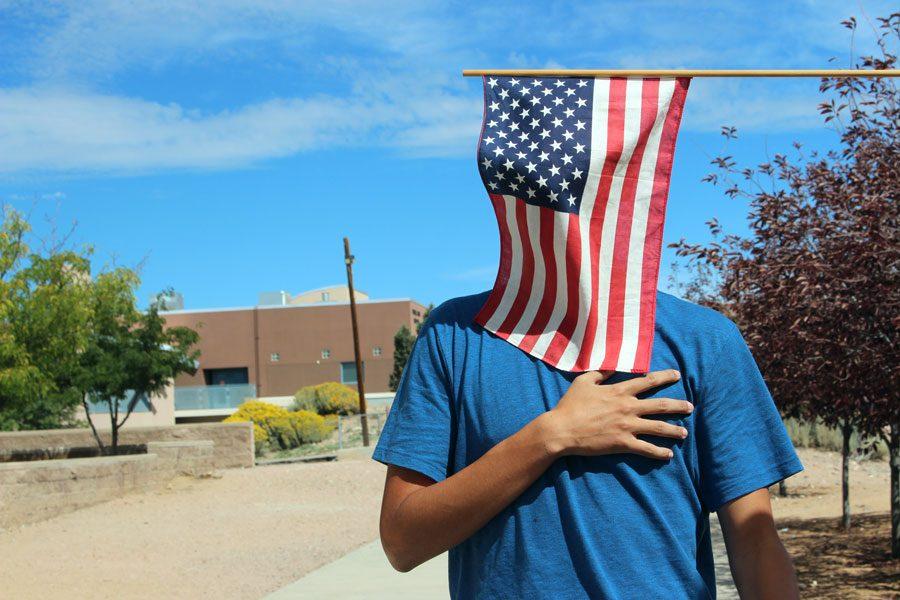To Stand or Not to Stand?
October 4, 2016
“Will I stand?”
This is the question many students in America ask themselves every day when the time comes to salute their flag.
The refusal to display loyalty has been recently debated in the media as Colin Kaepernick, the 49ers quarterback, has refused to stand for the national anthem.
“I am not going to stand up to show pride in a flag for a country that oppresses black people and people of color,” Kaepernick said.
Kaepernick is not the first professional athlete to take a stand for civil rights (or in this case, a kneel). Among those also raising awareness are athletes Dwayne Wade (Chicago Bulls) and LeBron James (Cleveland Cavaliers).
“At what point do we do something about it? At what point do we take a stand and as a people say this isn’t right?” Kaepernick asks. “I think it’s become so blatantly obvious that athletes and people in general have to react.”
In reaction to Kaepernick’s protest, former Republican presidential candidate Ted Cruz tweeted, “To all the athletes who have made millions in America’s freedom: stop insulting our flag, our nation, our heroes.”
So where should Americans draw the line?
In public schools across the country, pledging allegiance to the flag has become a daily routine. But how did this start?
In August of 1892, Francis Bellamy was asked to write a salute to the flag, which was to be recited in public schools as a show of patriotism. This was the foundation of the pledge we know today: “I pledge allegiance to my flag and the Republic for which it stands – one nation, indivisible – with liberty and justice for all.”
According to Encyclopedia Britannica, in 1954 President Eisenhower decided that the words “under God” were to be added to the pledge. (This is usually understood as Eisenhower’s desire to distinguish America from the anti-religious Soviets.) The change caused controversy in a rapidly diversifying America, calling into question the separation of church and state: Should we have a pledge that includes religious language?
This question has also been asked many times: Should students in public schools be forced to stand and recite this pledge?
According to the Bill of Rights Institute, in 1940, a 10-year-old student refused to stand and pledge allegiance because it went against his religion. As a Jehovah’s Witness, he believed that saluting the flag violated the second of the Ten Commandments. This case went to court, and the Supreme Court ruled on behalf of the school, deciding that schools could force children to salute the flag.
This came to court again, however, in 1943, when Marie and Gathie Barnette, children of a Jehovah’s Witness, were instructed by their father to refuse to salute the flag. They were expelled, and the case went to court. In this case, the Supreme Court decided that requiring students to stand and speak the pledge violated the First Amendment’s Free Speech clause. Although the Supreme Court ruled in favor of Marie and Gathie, students today still face challenges when refusing to stand.
Carlos Caldwell, AP Government and AP European History teacher at Santa Fe High, says that he agrees with the court’s decision, but adds, “It is only disrespectful to not stand if you are just simply being lazy.” He goes on to say, “Pledging an allegiance is a serious endeavor but it also becomes pointless or authoritarian when teachers attempt to punish students who do not want to for whatever reason.”
Santa Fe High senior Tim Norwood said, “Most of the kids that don’t stand up for the pledge in school aren’t doing it for the protest. They are either following the crowd or trying to be cool.” He said that students shouldn’t necessarily be forced to stand because everyone has different beliefs, but that refusing to stand for the pledge is highly disrespectful.
In addition to the national pledge, states can also have their own pledges. New Mexico’s flag salute briefly mentions the Zia symbol and the friendship among cultures. However, some states take it one step further. In 2001, Alabama established this pledge: “Flag of Alabama I salute thee. To thee I pledge my allegiance, my service, and my life.”
The Santa Fe Public Schools Board of Education Policy Manual states, “By law, the Pledge of Allegiance to the flag of the United States shall be recited in all schools on a daily basis.” However, it also states, “Students shall not be compelled to recite the Pledges, stand during the Pledges, or leave during the Pledges. No student shall disrupt or distract those who are reciting the Pledges.
When society, especially school, puts so much pressure on students to stand for the pledge, refusing can be a difficult process. If the school wishes to make a big deal about refusing, students will have to fight for it. If a student wishes to protest, however, New Mexico law, as well as the First Amendment, is on their side.
